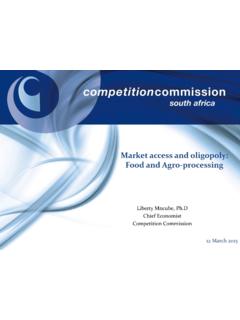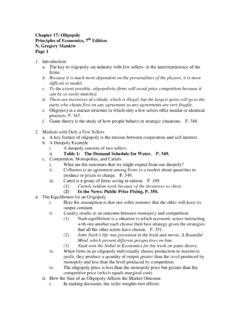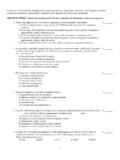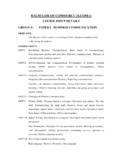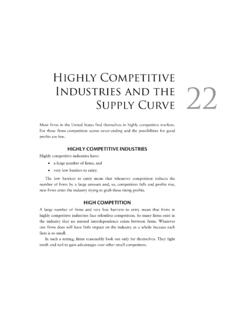Transcription of OLIGOPOLY - OECD.org
1 OLIGOPOLY 1999 The OECD Competition Committee debated oligopolies in 1999. This document includes an executive summary, an analytical note by Mr. Gary Hewitt for the OECD and submissions from Australia, Canada, the European Commission, Finland, Germany, Italy, Japan, Korea, the Netherlands, New Zealand, Norway, Sweden, Switzerland, the United Kingdom and the United States, as well as an aide-memoire of the discussion. Oligopolies are markets where profit maximising competitors set their strategies by paying close attention to how their rivals are likely to react. In these conditions, firms might differentiate their products, which can benefit some consumers, but at a price. OLIGOPOLY inter-dependence can also foster anti-competitive co-ordination. Competition laws prohibit collusion that raises prices, restricts output or divides markets. But the laws do not prohibit conscious parallelism.
2 Thus firms in an OLIGOPOLY might imitate their rivals pricing and other competitive behaviour in a process that harms consumer welfare, yet without reaching an explicit agreement. Competition agencies generally prefer to deal with this risk through structural prevention, notably merger control, rather than detailed regulation. Some competition agencies also employ behavioural restraints to reduce the probability of conscious parallelism. Fighting Hard Core Cartels: Harm, Effective Sanctions and Leniency Programmes (2002) Nature and Impact of Hard Core Cartels and Sanctions against Cartels under National Competition Laws (2002) OECD Recommendation of the Council Concerning Effective Action Against Hard Core Cartels (1998) Competition Policy and Procurement Markets (1998) Regulatory Reform, Privatisation and Competition Policy (1992) UnclassifiedDAFFE/CLP(99)25 Organisation de Coop ration et de D veloppement EconomiquesOLIS :19-Oct-1999 Organisation for Economic Co-operation and DevelopmentDist.
3 :21-Oct-1999_____Or. FOR FINANCIAL, FISCAL AND ENTERPRISE AFFAIRSCOMMITTEE ON COMPETITION LAW AND POLICYOLIGOPOLYU nclassifiedDAFFE/CLP(99)25Or. complet disponible sur OLIS dans son format d origineComplete document available on OLIS in its original formatDAFFE/CLP(99)252 FOREWORDThis document comprises proceedings in the original languages of a Roundtable on Oligopolywhich was held by the Committee on Competition Law and Policy in May is published under the responsibility of the Secretary General of the OECD to bringinformation on this topic to the attention of a wider compilation is one of several published in a series entitled "Competition PolicyRoundtables".PR FACECe document rassemble la documentation dans la langue d'origine dans laquelle elle a t soumise, relative une table ronde sur les oligopoles qui s'est tenue en mai 1999 dans le cadre de lar union du Comit du droit et de la politique de la est publi sous la responsabilit du Secr taire g n ral de l'OCDE afin de porter laconnaissance d'un large public, les l ments d'information qui ont t r unis cette compilation fait partie de la s rie intitul e "Les tables rondes sur la politique de laconcurrence".
4 Visit our Internet Site -- Consultez notre site (99)253 OTHER TITLESSERIES ROUNDTABLES ON COMPETITION Policy and Environment(Roundtable in May 1995, published in 1996)OCDE/GD(96) Firm Defence(Roundtable in May 1995, published in 1996)OCDE/GD(96) Policy and Film Distribution(Roundtable in November 1995, published in 1996)OCDE/GD(96) Policy and Efficiency Claims in Horizontal Agreements(Roundtable in November 1995, published in 1996)OCDE/GD(96) Essential Facilities Concept(Roundtable in February 1996, published in 1996)OCDE/GD(96) in Telecommunications(Roundtable in November 1995, published in 1996) OCDE/GD(96) Reform of International Satellite Organisations(Roundtable in November 1995, published in 1996)OCDE/GD(96) of Dominance and Monopolisation(Roundtable in February 1996, published in 1996)OCDE/GD(96) of Competition Policy to High Tech Markets(Roundtable in April 1996, published in 1997)OCDE/GD(97) Cartel Bans: Criteria for Exemption for Small andMedium-sized Enterprises(Roundtable in April 1996, published in 1997)OCDE/GD(97) Issues related to Sports(Roundtable in October 1996, published in 1997)OCDE/GD(97) of Competition Policy to the Electricity SectorOCDE/GD(97)132(Roundtable in October 1996, published in 1997) Enforcement of Competition LawOCDE/GD(97)200(Roundtable in October 1996, published in 1997) Price Maintenance(Roundtable in February 1997, published in 1997)OCDE/GD(97)229 DAFFE/CLP(99).
5 Structure, Regulation and Competition Policy(Roundtable in October 1997, published in 1998)DAFFE/CLP(98) Policy and International Airport ServicesDAFFE/CLP(98) the Role of Competition in the Regulation of BanksDAFFE/CLP(98) Policy and Intellectual Property RightsDAFFE/CLP(98) and Related Regulation Issues in the Insurance IndustryDAFFE/CLP(98) Policy and Procurement MarketsDAFFE/CLP(99)3 and Competition Issues in BroadcastingDAFFE/CLP(99)1in the Light of between Regulators and Competition AuthoritiesDAFFE/CLP(99) Power of Multiproduct RetailersDAFFE/CLP(99) Competition in Postal ServicesDAFFE/CLP(99)22 DAFFE/CLP(99)255 TABLE OF CONTENTSEXECUTIVE SUMMARY .. 7 SYNTH 11 BACKGROUND NOTE .. 17 NOTE DE R F RENCE .. 53 SECRETARIAT SUGGESTED ISSUES FOR DELEGATES 91 QUESTIONS SUGG R ES POUR LES CONTRIBUTIONS DES D L GU S .. 93 NATIONAL CONTRIBUTIONSA ustralia .. 129 Germany .. 135 Italy.
6 151 Korea .. 159 New Zealand .. 161 Norway .. 171 Sweden .. 183 United 191 United States .. 199 European Commission .. 213 OTHERSU nited StatesDepartment of Justice, Antitrust Division .. 225 AIDE-MEMOIRE OF THE DISCUSSION .. 253 AIDE-M MOIRE DE LA DISCUSSION .. 271 DAFFE/CLP(99)256 DAFFE/CLP(99)257 EXECUTIVE SUMMARYby the SecretariatConsidering the discussion at the roundtable, the delegate submissions, and the backgroundpaper, the following key points emerge: Mutually aware that their actions will produce reactions from rivals, oligopolists have a strongincentive to substitute anti-competitive co-operation for vigorous competition. Such behaviour,referred to in what follows as "co-ordinated interaction", has negative welfare effects. This isespecially clear in the case of welfare losses associated with co-ordinated interaction are qualitatively the same as thoselinked to monopoly, higher prices, X-inefficiency, slower innovation, and reduced product examples of co-ordinated interaction other than collusion are price leadership, delivered pricing, andprice stickiness around certain focal points.
7 There is a considerable gap between the desire to engage in co-ordinated interaction and the ability todo so successfully. It can be difficult to reach mutually acceptable terms of co-operation, and toensure that firms do not deviate from co-operating oligopolists could have dissimilar costs and face different demandconditions as well. While such differences may not pose a major problem for anti-competitive co-ordination of non-price rivalry, they could make it difficult for firms to settle on mutually beneficial pricelevels and price gaps among the various goods on offer. Even where these issues are resolved, successfulco-operation regarding prices is not assured. Once price has been raised significantly above marginal cost,each oligopolist will have an incentive to shade its prices especially if it believes this will escape detectionand retaliation.
8 Durable co-operation often requires that oligopolists work out ways to increase theprobability of detection and the certainty of punishment for cheating, all the while avoiding prosecution foranti-competitive behaviour.[Despite the evident difficulties, large scale and long running cartels are known to exist as evidenced bythe increasing number of such cartels currently being prosecuted in a number of OECD Members.]Behavioural Remedies The principal behavioural remedy for co-ordinated interaction is prohibition of collusion backed up byheavy fines and, in some countries, imprisonment. Because of the heavy sanctions, colluders generallyavoid creating direct evidence of anti-competitive communications. This makes it difficult to detectand prove collusion, and explains why competition agencies are often forced to rely on circumstantialevidence. However, evidence of parallel conduct is not and should not be considered sufficient proofof (99)258 The most common circumstantial evidence consists of closely parallel behaviour.
9 The legal andeconomic problem with such evidence is that parallel behaviour could have causes other than collusion. Inoligopoly settings, parallel price movements for example could arise simply through independent rationalbehaviour. To convince courts that parallel behaviour has arisen through some kind of agreement ratherthan merely resulting from oligopolistic interdependence, competition authorities must usually demonstratethat something more has occurred, establish the existence of one or more "plus factors". These arebasically forms of conduct that would not be economically rational absent some agreement amongcompetitors. Courts have also been willing to consider evidence that a particular market structurefacilitates collusion. This may be changing, however, since it is increasingly recognised that a marketstructure conducive to collusion would also facilitate forms of co-operation falling short of such courts are inclined to presume that firms would not take the legal risks of colluding if they couldreadily achieve the same result in a more flexible, less risky OECD countries have reacted to the problems associated with proving collusion bywidening the net to prohibit "concerted practices", and in a few countries, "facilitating practices" (seebelow) as well.
10 One country s competition act goes even further by providing presumptions that certainacts constitute evidence of collusion even if there has been no explicit to widen what is caught by prohibitions of anti-competitive horizontal agreements andto lower burdens of proof could result in countries effectively outlawing the kind of parallel behaviour thatoligopolistic interdependence strongly fosters. But parallel behaviour induced by interdependence cannotbe eradicated with behavioural measures short of ongoing regulation of competitive conduct, a cure that isworse than the disease. In order to increase the chances for successful collusion, and in particular to improve abilities todetect and punish cheating, co-operating firms may employ what are known as "facilitating practices".Some countries prohibit such practices either as abuses of dominance or as themselves constitutinganti-competitive agreements.











